Years ago, I hosted a “Science Party” for my eight-year-old daughter to test flowers from our garden for acid/base color indicators. Ten of her friends came over, and spent HOURS at it, skipped lunch (!) and some had to be dragged away. The agenda was to gather flowers and such from the gardens and greenhouse (orchids too!) and smoosh them in a mortar and pestle with a bit of rubbing-alcohol (When I was a teenager, I experimented and found this to be the BEST solvent for this purpose). Then a dropper could suck-up the (usually) colored solution to put a few drops into each of three tubes, adding acid to one, water to one, and alkali to the third. I had bought each of them a set of safety goggles, plastic droppers and a rack of 25 little plastic test-tubes to take home (surplus).
Some surprises came up, like the prevalence of flavonoids that turn yellow with strong alkalis (so some samples go red-purple-blue-green with increasing pH). They're the reason why when you wash your hands after handling tomato plants the soap turns yellow: You can easily collect lots of some weird pigment by stroking tomato stems with a cotton-ball, and it turns bright greenish-yellow in alkali.
Materials were obtained from American Science & Surplus at good prices:
American Science & Surplus
3605 Howard street,
Skokie IL 60076
(847) 982-0870
http://www.sciplus.com/
List of Materials
- Safety Goggles $2.25 ea.
- Test Tubes (at least five) $1.75 ea.
- Test Tube Rack
- Mortar and Pestle $13.95 ea.
- Droppers Provided $2.00/20.
- Acid: distilled vinegar, lemon juice
- Alkali: household ammonia, baking soda
- Solvent: rubbing alcohol
- Apron or Lab Coat Recommended
- Pigmented plant parts: flowers, berries, pods.
- Acidic foods like fruits, alkaline like soda- or shortbread or cake.
- Miscellaneous, if available and needed: Ph Meter, Litmus paper, Acid/base indicators, tincture of iodine
1. We will do experiments to try to extract the colours from plant parts like flowers, leaves and fruits.
2. We will then determine if these chemicals change colour when they are mixed with acids and alkalis. That is, are they acid/base indicators.
3. Using any acid/base indicators we find, we will try to identify whether some foods are acidic or alkaline (basic).
Procedures (The three experiments can be run concurrently):
Experiment 1
- Obtain a pigmented plant part, the darker the better. The dryer the better. If possible, cut away any uncoloured parts.
- Smoosh and Goosh it up in a mortar and pestle.
- Add a little rubbing alcohol and carefully grind it up some more.
- Pour, or use a dropper to remove the liquid to a test tube. Label the tube. What does it look like?
- Wash the mortar and pestle and repeat.
- Put a few drops of the extracted pigment from experiment 1 into each of five test tubes.
- Put three drops of ammonia or baking soda solution in the left test tube. What happens?
- Put three drops of vinegar or lemon juice solution in the right test tube. What happens?
- Put one drop of ammonia or baking soda solution in the next to left test tube, and two drops of water. What happens?
- Put one drop of vinegar or lemon juice solution in the next to right test tube, and two drops of water. What happens?
- Put three drops of water in the center test tube. Compare the colors of each sample.
- Put a few drops of the extracted pigment from experiment 1, one that changes colours, into each of five test tubes.
- Put three drops of ammonia solution in the left one, three drops of baking soda solution in the next. What happens?
- Put three drops of vinegar in the right one and three of lemon juice solution in the next. What happens?
- Put three drops of water in the middle tube. Compare the colours.
- Using the results of the experiment above, if you add a drop of vinegar to the left (ammonia) tube and a drop of water to the middle one, and a drop of ammonia to the right (vinegar) tube, how many times do you have to repeat to get them the same colour?
Experiment 3
- Obtain a food (or other material) sample.
- Put a few drops of the extracted pigment from experiment 1, one that is shown to be an indicator, onto the sample. What happens. Is the sample acidic or alkaline?
The pigments in plants fall into one of several chemical families. Blue, purple, pink, and most red colours are due to the presence of one or another of the anthocyanin pigments, which are acid/base indicators. [antho means “flower,” cyanin means “blue.”] Their molecular shape changes in response to acidity, and this changes their colour. Some blue flowers have the same anthocyanin pigment as some pink ones; the difference is in the acidity/alkalinity (pH) of the plant juice. Vinegar and lemon juice are acidic, ammonia and baking soda alkaline. Float flowers in them and the flowers will likely change colour.
Anthocyanins are soluble in water and alcohol and are easy to extract, They also are usually easily destroyed by heat (cooking). Beets and chard (and cacti) have pigments in a different group, betacyanins, which are more heat stable and are also (barely) indicators. [Beta means “beet.”]
Yellow, orange and some red pigments (as in tomatoes) are due to carotenoid pigments, which are not acid/base indicators, and are not really soluble in water and sparingly in alcohol. [carota means “carrot”] Green chlorophyll and various brownish pigments may also be present.
There are other experiments that can be done: baking soda combined with an acid makes bubbles (carbon dioxide), tincture of iodine from the medicine cabinet gives a black/blue colour on starch and can be used to detect starchy foods and where in a plant starch is stored.








